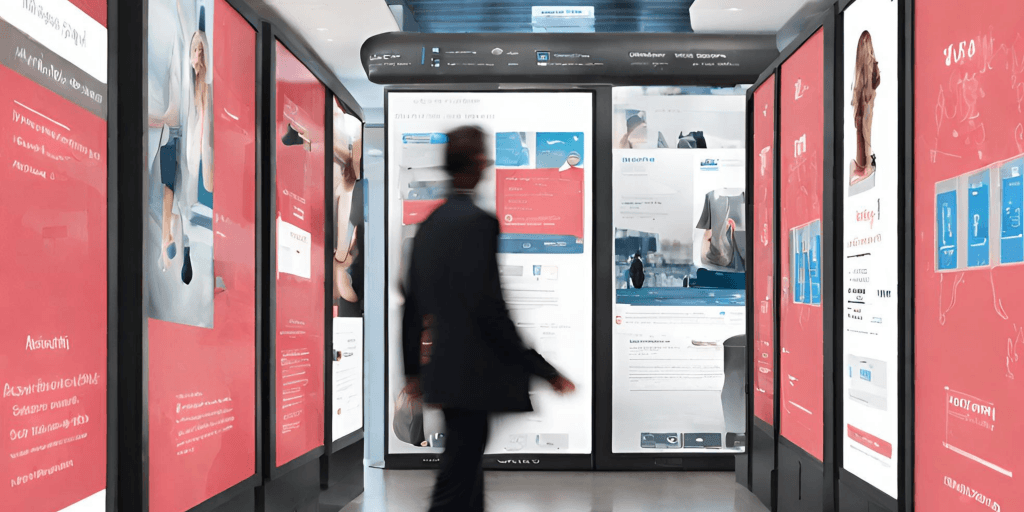The contemporary global environment implies that companies, schools, hospitals, and entertainment venues opt for digital signage as a contemporary tool of information sharing. The use of digital displays for presenting dynamic content has come a long way from its basic uses of messaging. The emergence of AI in digital signage is slowly turning this marketing medium into a platform that can provide highly targeted and engaging content.
As digital signage and AI continue to merge, it is transforming industries, customers’ experience, operational effectiveness, and the future smart communication.
The Evolution of Digital Signage
Digital signage means any form of electronic display that is used to inform, advertise or to display any message in any area accessible to the public. It can be a small screen in a shop to a large outdoor Electronic Display in a city. The use of digital signage has grown from the use of simple and static advertisement to that of dynamic and real time advertisement. Due to the availability of advanced technology it has become relatively easier to revise content online, to show high quality video and insert live data feeds such as a news ticker or a weather crawl.
But, digital signage on its own has some drawbacks. For example, it can grab the public’s attention, but there is no way to engage the audience or adapt content to their preferences. This is where AI comes into play, to provide a solution for enhancing digital signage, which is intelligent, reactive as well as effective.
The Role of AI in Digital Signage
The advancement of artificial intelligence in the capacity to process data, identify patterns and make decisions promptly is dramatically changing the function of digital signage. Here are some key ways AI is enhancing digital signage systems:
1. Personalized Content Delivery
Personalization is one of the most notable ways through which AI helps to improve digital signage. The use of AI algorithms means it is possible to factor in aspects such as the demographic and geographical location of the audience, the time of the day and even the weather in order to find the most relevant content to show. For example, in a retail environment, AI can use cameras or sensors to predict the age, gender or smile of a pedestrian and adjust the information on the sign accordingly. This means that every individual is targeted with a specific advert which is most appropriate to him or her thus improving the chances of the advert being successful.
2. Digital Signage and Audience Analytics
Business owners can get insights about the targeted audiences through AI based digital signage systems. These systems, for instance, facial recognition, and computer vision can capture the number of people that have an interaction with the signs, the duration of the interaction, and even the emotions. Such information can be beneficial for marketers since it allows them to evaluate their campaigns and improve the communication with customers. In addition, through this data, businesses can categorize their audience and, therefore, develop better material that can be posted on their various platforms.
3. Dynamic Content Adaptation
AI enables digital signage to change the content in response to external conditions. For instance, in a quick service restaurant AI can monitor the number of people entering the store and sales and then change the menu to promote the items that are likely to sell during that period or when the inventory is low. In a retail environment, AI can change advertising signs based on the weather; umbrellas during rainy weather, or sunscreen during sunny weather. Such dynamic adaptability is beneficial in that, it makes the content as relevant as possible to the target audience and helps sell products and attract customers.
4. Voice and Gesture Recognition
As AI becomes part of the digital signage it is not limited to visuals but also voice and gesture. AI helps customers to control digital signs through natural voice and gestures, thanks to voice and gesture recognition technologies. For instance, in the shopping malls or airports, the visitors themselves can ask the signage for directions, products and other relevant information. This also improves the user experience while also providing brands with a new way to interact with consumers at a more fundamental level.
5. Predictive Maintenance and Operational Efficiency
AI can also be used discreetly to manage the effective operation of digital signage systems. Some of the application of predictive maintenance include; technical problems related to digital displays can be detected early by using algorithms. This results in less time spent on machines, and reduces the call for frequent repairs. In the same vein, AI can also control brightness levels to ensure that it adapts to the surrounding environment hence consuming as little energy as possible.
Industry Applications of AI-Enhanced Digital Signage
AI and digital signage are proving to be the perfect mix in a world of endless opportunities in multiple sectors. Here are a few examples of how different sectors are benefiting from this technology:
1. Retail Customer Experience
In the retail industry, AI digital signage is now the new frontier of the future. Using AI, stores can track the movement of customers within stores and their behavior in real time and then adjust the position of signs in order to show promotional offers or goods most likely to interest given segments. Third, the content can be customized such as the ads that are likely to be preferred by customers based on profiles or interests. Another application of AI by the retailers is by advising them on recommending products that are hot in the market, or those that their customers have bought before.
2. Hospitality and Tourism
Digital Signage in airport, hotels and tourism AI digital signage creates a higher level of interaction and satisfaction to the travelers. Incorporation of voice commands or gesture recognition allows tourists to be led to main attractions, provide details about specific flights or even the current weather. Examples of application of digital signage in hotels includes; welcoming guests by name, displaying the event calendar or recommending restaurants for breakfast, lunch or dinner depending on the time or weather.
3. Healthcare
Use of digital signage is directing patients in hospitals and clinics, making patients feel that they are not waiting for too long, and conveying relevant information electronically. Patients are often said to require information at the right time and AI can be used to determine when such time is most likely to be or offer information to patients depending on their needs at any given time. AI integrated signs may also help the patients to navigate large healthcare facilities and that relieves stress.
4. Education
Schools and universities are incorporating digital signage to advance their communication and assist with teaching and learning. AI can be used in the form of schedule announcements or event information to be tailored according to different student groups derived from the enrollment systems. Moreover, the smart interactive boards that use AI can enhance the students’ engagement by presenting them with more engaging and dynamic content of which the content changes depending on the interaction of the students.
5. Trade Facilities
Theaters and concert halls and entertainment and sports stadiums have installed AI digital signage to create more exciting experiences for the visitors. AI can be used to relay event schedules to fans, help them find their seats or tell them what is available and the time of day. Further, the AI-based audience analysis will allow event organizers to increase their knowledge of fans’ behavior and improve their content distribution for upcoming events.
Future Trends and Opportunities
As AI and digital signage technologies continue to evolve, several trends are emerging that will shape the future of this dynamic duo:
1. Increased Integration with IoT: Digital signage will have its capabilities enhanced by the Internet of Things (IoT). Other connected devices and sensors can give even more data to the AI algorithms, which means even better personalization and even better content delivery.
2. Immersive Experiences with AR and VR: AI interacted with AR and VR will result in digital signage that will merge with the physical environment. For instance, consumers could touch the screen to see how the product would look in one’s home.
3. Smarter Data Security and Privacy: While digital signage continues to advance towards being more personalized and using data, both privacy and data protection will be significant concerns. Forging technologies in AI will incorporate improved methods of encryption and increased conformity to privacy laws to safeguard user data.
Conclusion
The integration of digital signage and Artificial Intelligence is revolutionizing the way organizations engage consumers. AI, through the delivering of customized content, real-time data processing, engagement, and management, has brought out the best of digital signage. This synergy is not only creating great customer experiences but is also offering insights to the organizations to improve their marketing and growth strategies.
In the future, thanks to the developments in AI, digital signage will be smarter and will be able to be adjusted according to the requirements, thus changing the industries and introducing the era of smart communication.





